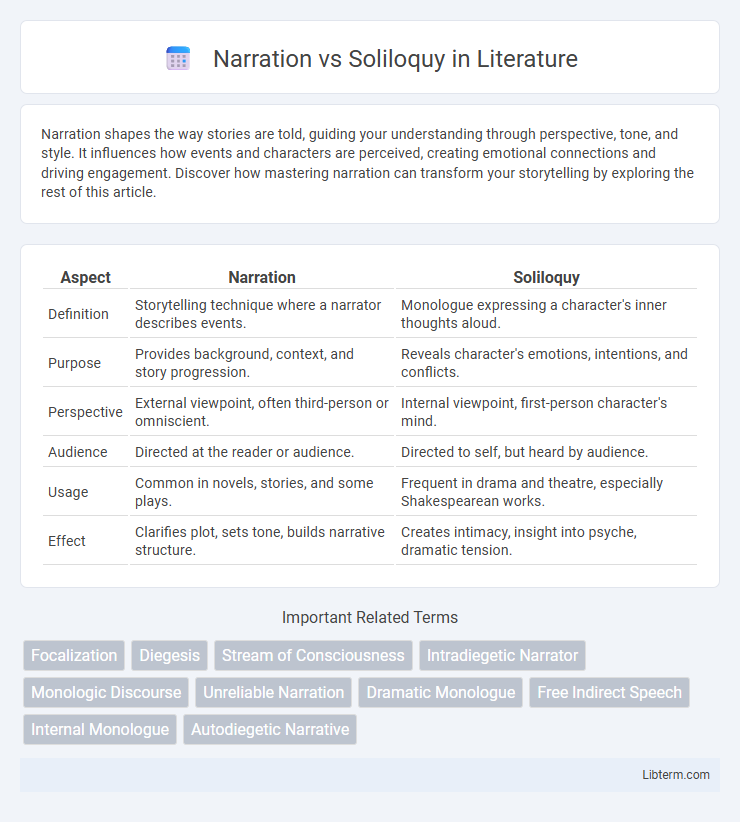Narration shapes the way stories are told, guiding your understanding through perspective, tone, and style. It influences how events and characters are perceived, creating emotional connections and driving engagement. Discover how mastering narration can transform your storytelling by exploring the rest of this article.
Table of Comparison
| Aspect | Narration | Soliloquy |
|---|---|---|
| Definition | Storytelling technique where a narrator describes events. | Monologue expressing a character's inner thoughts aloud. |
| Purpose | Provides background, context, and story progression. | Reveals character's emotions, intentions, and conflicts. |
| Perspective | External viewpoint, often third-person or omniscient. | Internal viewpoint, first-person character's mind. |
| Audience | Directed at the reader or audience. | Directed to self, but heard by audience. |
| Usage | Common in novels, stories, and some plays. | Frequent in drama and theatre, especially Shakespearean works. |
| Effect | Clarifies plot, sets tone, builds narrative structure. | Creates intimacy, insight into psyche, dramatic tension. |
Understanding Narration and Soliloquy
Narration involves a character or narrator describing events, providing context and background to help the audience understand the plot and characters' motivations. Soliloquy is a dramatic device where a character speaks their inner thoughts aloud, revealing emotions and conflicts directly to the audience without interaction with other characters. Understanding narration and soliloquy enhances comprehension of storytelling techniques and character development in literature and drama.
Defining Narration in Literature
Narration in literature refers to the method by which a story is told through a narrator who provides a structured account of events, thoughts, and background details. It establishes the narrative perspective, whether first-person, third-person limited, or omniscient, guiding the reader's understanding of the plot and characters. Distinct from soliloquy, which reveals a character's inner thoughts aloud, narration serves to convey the overarching story context and progress from an external or internal viewpoint.
Exploring the Concept of Soliloquy
Soliloquy is a dramatic device where a character speaks their thoughts aloud while alone on stage, providing deep insight into their inner feelings and motivations. Unlike narration, which conveys story information directly to the audience or readers, soliloquy allows for intimate self-expression and psychological exploration within a play. Famous examples in Shakespeare's works, such as Hamlet's "To be or not to be," exemplify how soliloquies reveal complex character dilemmas and advance the plot through internal dialogue.
Key Differences Between Narration and Soliloquy
Narration involves a character or narrator recounting events directly to the audience, providing context and background information, while soliloquy is an introspective speech delivered by a character alone on stage to reveal their inner thoughts and emotions. Narration often serves to advance the plot or explain situations outside the immediate action, whereas soliloquies offer deep psychological insight and personal conflict resolution. The key difference lies in narration's external storytelling function versus soliloquy's internal self-expression within a dramatic work.
The Role of Narration in Storytelling
Narration in storytelling provides crucial context and background, guiding the audience through a coherent plot and enhancing character development. Unlike soliloquy, which reveals a character's internal thoughts directly, narration offers an external perspective that frames events and deepens thematic understanding. This narrative voice establishes tone, pace, and coherence, making complex stories accessible and engaging.
The Purpose of Soliloquy in Drama
Soliloquy in drama serves the purpose of revealing a character's innermost thoughts and emotions directly to the audience, providing insight that cannot be conveyed through dialogue or narration. Unlike narration, which describes events or background information, soliloquies enable deeper character development and understanding of motivations. This dramatic device enhances the emotional connection and clarifies plot intentions by exposing internal conflicts and personal reflections.
Effects on Audience Engagement
Narration provides an external perspective that guides audience interpretation and maintains plot clarity, enhancing overall comprehension and emotional connection. Soliloquy offers direct insight into a character's innermost thoughts, fostering intimacy and deep psychological engagement. The combination of both techniques balances narrative exposition with personal reflection, effectively sustaining audience interest and empathy.
Famous Examples of Narration and Soliloquy
Famous examples of narration include the opening lines of Charles Dickens' *A Tale of Two Cities*, where the narrator sets the historical context and tone. Shakespeare's soliloquies, notably Hamlet's "To be, or not to be" speech, provide deep insight into a character's inner thoughts and conflicts. Both narration and soliloquy serve distinct narrative functions, with narration guiding the audience through the story and soliloquy revealing personal dilemmas directly from the character's mind.
Narration vs Soliloquy: When to Use Each
Narration serves to provide background information, advance the plot, or offer insights that characters may not express, making it ideal for setting scenes or explaining events. Soliloquy is used primarily in drama to reveal a character's inner thoughts and emotions directly to the audience, typically during moments of introspection or conflict. Use narration to maintain story flow and provide context, while soliloquy is best for deep character development and emotional expression.
Impact on Character Development
Narration provides external insight into a character's thoughts and motivations, allowing the audience to understand their background and emotional state, which enriches character development through an omniscient perspective. Soliloquy offers direct access to a character's inner conflicts and personal reflections, revealing their true intentions and emotional complexity in real-time. This intimate self-expression enhances character depth by showcasing vulnerability and evolving psychological states.
Narration Infographic

 libterm.com
libterm.com